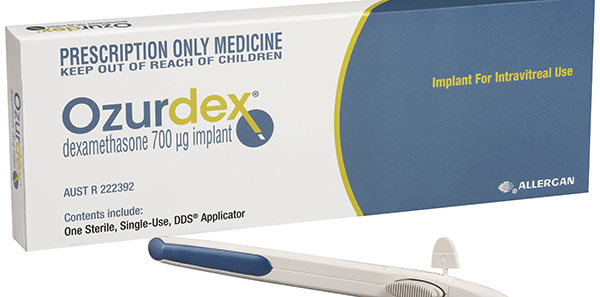1:30min

Image: Allergan Australia
______________________________
By Helen Carter
Journalist
Ozurdex (dexamethasone) sustained release eye implant is the first corticosteroid and the first intravitreal steroid listed on the Pharmaceutical Benefits Scheme for diabetic macular oedema (DME).
Optometrists do not prescribe dexamethasone but patients can get a prescription from an ophthalmologist.
In other PBS news, the cost of latanoprost and dorzolamide eye-drops has been reduced under the PBS (see below).
Ozurdex was listed on 1 November 2016 for adults with DME who have had cataract surgery or are scheduled to have cataract surgery and cannot use vascular endothelial growth factor inhibitors (anti-VEGFs) because this first-line treatment is ineffective or not appropriate for them.
Reasons for being unable to use anti-VEFGs include if they have a contraindication to a VEGF inhibitor, they have failed to respond to a VEGF inhibitor or a VEGF inhibitor is otherwise unsuitable for them.
The steroid is contained within a small slow-release implant injected into the back of the eye by an ophthalmologist using a single-use applicator. The medication is slowly released into the vitreous, reducing swelling, which helps to lessen or prevent more damage to the macula.
Based on clinical trial data, the effect of each implant typically lasts four to six months.
An Allergan media release said the treatment provided rapid and sustained vision improvement with few injections. In clinical trials Ozurdex delivered a rapid and significant vision improvement of 15 or more letters compared with sham treatment in DME patients as early as 21 days after study treatment.
It also provided sustained, long-term improvements in vision in DME patients with a mean of four injections over three years, compared with sham treatment. An in vitro study found that Ozurdex could inhibit not only VEGF but also a range of other inflammatory mechanisms implicated in the development of DME.
University of Sydney ophthalmologist Professor Mark Gillies said the novel, biodegradable eye implant provided an important new option for DME.
Macular Disease Foundation Australia CEO Julie Heraghty said: ‘The federal government should be congratulated for reimbursing another important treatment option for people with sight-threatening diabetic macular oedema. This is the first treatment option in a new class of therapy for diabetic macular oedema and may provide certain patients with a more appropriate option when anti-VEGF treatments are either ineffective or not appropriate.’
The PBS website says the authority-required 700 microgram implant previously cost $1,836.15 but now the maximum price to the patient will be $38.30.
About 72,000 Australians have DME and more than 1.7 million Australians have diabetes.
Up to 50 per cent of Australians with diabetes do not undergo eye examinations as recommended every two years, according to the Deloitte Access Economics report, The Economic Impact of Diabetic Macular Oedema in Australia.
Eye-drops price cut
The price reductions of latanoprost and dorzolamide under the Pharmaceutical Benefits Scheme came into effect on 1 October 2016.
The eye-drop medications are two of more than 2,000 medicine brands that have reduced in price, some by as much as $20 per script.
- Latanoprost eye-drops 50 micrograms per mL, 2.5 mL, was $23.00 per script but is now $17.95, a price difference of $5.05.
- Latanoprost with timolol eye-drops containing 50 micrograms latanoprost with timolol 5 mg (as maleate) per mL, 2.5 mL, was $27.45 per script but is now $22.40, a saving of $5.05.
- Dorzolamide with timolol eye-drops containing dorzolamide 20 mg (as hydrochloride) with timolol 5 mg (as maleate) per mL, 5 mL, was $25.72 per script but is now $23.55.
These savings are the result of the PBS Access and Sustainability Package reforms which passed Parliament last year.